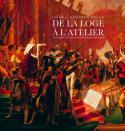De la loge à l’atelier, peintres et sculpteurs francs-maçons
Nathalie Kaufmann-Khelifa
Is there a Masonic-type painting and if so, how does one recognize it? These are the questions that more or less guide the author in this intriguing panorama that pretends to reveal some secrets, such as the idea that Géricault was a Mason and showered his famous Radeau de la Méduse with transparent symbols. As one reads on we learn that many other artists, such as Hogarth or Félicien Rops, all had a close tie with various lodges and that some suffered from that, like Alfons Mucha, brutally questioned by the Nazis in Prague when he was 80 years old, which precipitated his demise. Other less-known anecdotes and characters shed light on the theme: Joseph Vernet illustrated Paul et Virginie and convinced its author, Bernardin de Saint-Pierre, whom he met in a lodge meeting, not to throw the manuscript into the fire after a first catastrophic public reading. Juan Gris, who was introduced into the obedience by Lipschitz in 1922, always started his paintings with a compass and a T-square … Grant Wood (1891-1942), who was from a devoted Quaker family in Iowa, joined the Masons in part to escape the stifling atmosphere of the conservative Middle West. Up to his death, the “painter with overalls” was systematically ostracized, which did not prevent him from producing one of the icons of American painting of the XXth century, American Gothic.
|  |
Review published in the newsletter #323 - from 21 November 2013 to 27 November 2013
